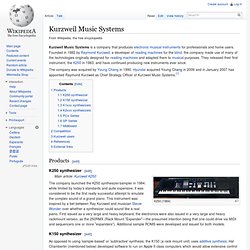

The Law of Accelerating Returns. Ray Kurzweil & Moore's law.
The Singularity Is Near. The Singularity Is Near: When Humans Transcend Biology is a 2005 non-fiction book about artificial intelligence and the future of humanity by inventor and futurist Ray Kurzweil.

This is his first book to embrace the Singularity as a term, but the ideas contained within are derived from his previous books, the The Age of Spiritual Machines (1999) and The Age of Intelligent Machines (1990). Kurzweil describes his law of accelerating returns which predicts an exponential increase in technologies like computers, genetics, nanotechnology, robotics and artificial intelligence. He says this will lead to a technological singularity in the year 2045, a point where progress is so rapid it outstrips humans' ability to comprehend it. Irreversibly transformed, people will augment their minds and bodies with genetic alterations, nanotechnology, and artificial intelligence. Content[edit] Exponential growth[edit] Computational capacity[edit] Moore's Law The brain[edit] Exponential Growth of Computing.
RAY KURZWEIL - That Singularity Guy - Vice Magazine. In the year 2050, if Ray Kurzweil is right, nanoscopic robots will be zooming throughout our capillaries, transforming us into nonbiological humans.

We will be able to absorb and retain the entirety of the universe’s knowledge, eat as much as we want without gaining weight, shape-shift into just about any physical form imaginable, live free from disease, and die at the time of our choosing. All of this will be thrust on us by something that Kurzweil calls the Singularity, a theorized point in time in the not-so-distant future when machines become vastly superior to humans in every way, aka the emergence of true artificial intelligence. Computers will be able to improve their own source codes and hardware in ways we puny humans could never conceive. This will result in a paradigm shift that sees mankind coalescing with its own creations: man and machine, merging into one. That kind of correspondence will only be possible if we develop advanced artificial intelligence and nanotechnology. Ray Kurzweil: Music Making - Past, Present and Future (1 of 3) Kurzweil Music Systems.
Kurzweil Music Systems is a company that produces electronic musical instruments for professionals and home users.

Founded in 1982 by Raymond Kurzweil, a developer of reading machines for the blind, the company made use of many of the technologies originally designed for reading machines and adapted them to musical purposes. They released their first instrument, the K250 in 1983, and have continued producing new instruments ever since. The company was acquired by Young Chang in 1990. Hyundai acquired Young Chang in 2006 and in January 2007 has appointed Raymond Kurzweil as Chief Strategy Officer of Kurzweil Music Systems.[1] Products[edit] K250 synthesizer[edit] The company launched the K250 synthesizer/sampler in 1984: while limited by today's standards and quite expensive, it was considered to be the first really successful attempt to emulate the complex sound of a grand piano.
K150 synthesizer[edit] K1xxx synthesizers[edit] K2xxx synthesizers[edit] K2600 (1999) on home studio PC88 on stage.
Kurzweil. Transcendent Man.